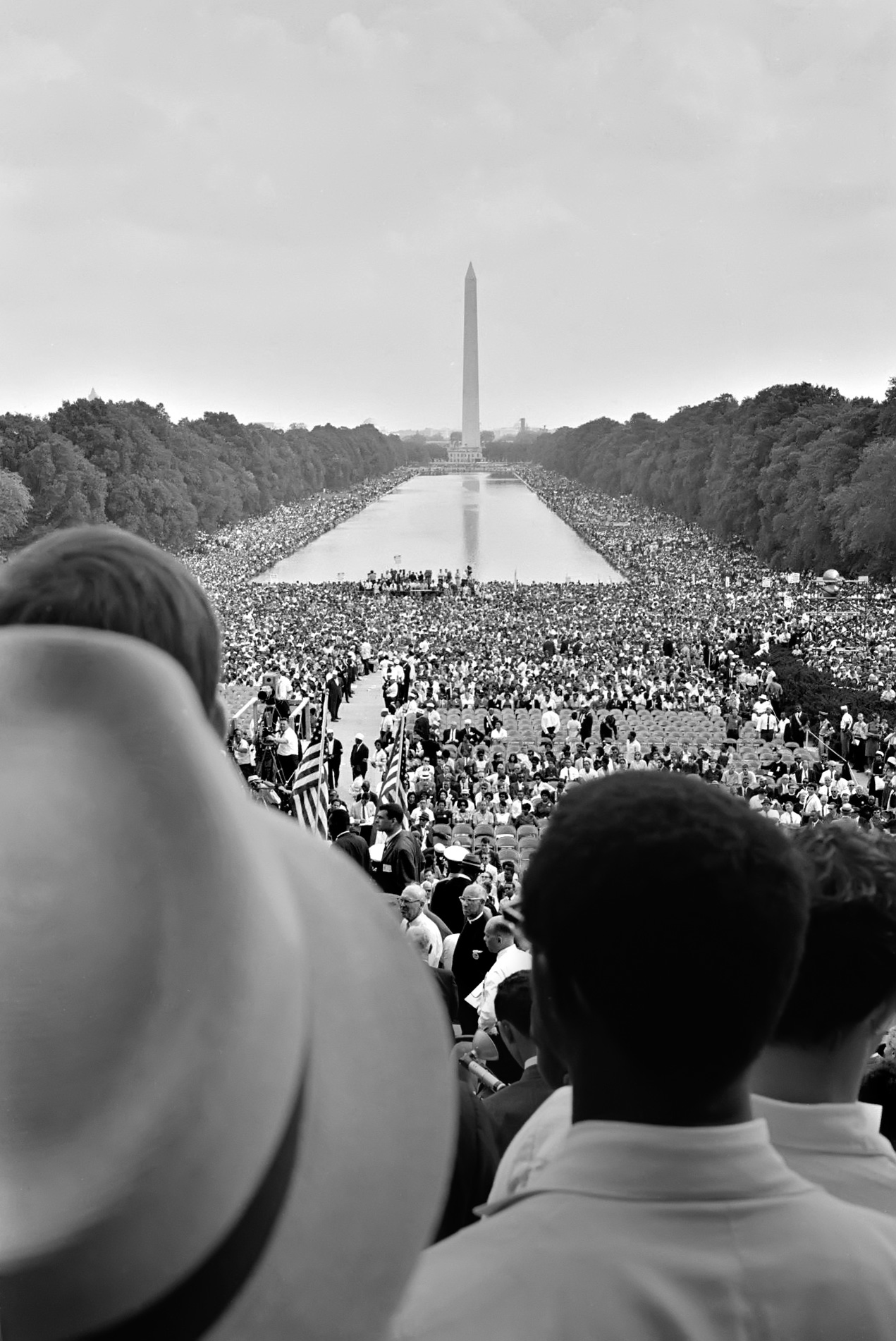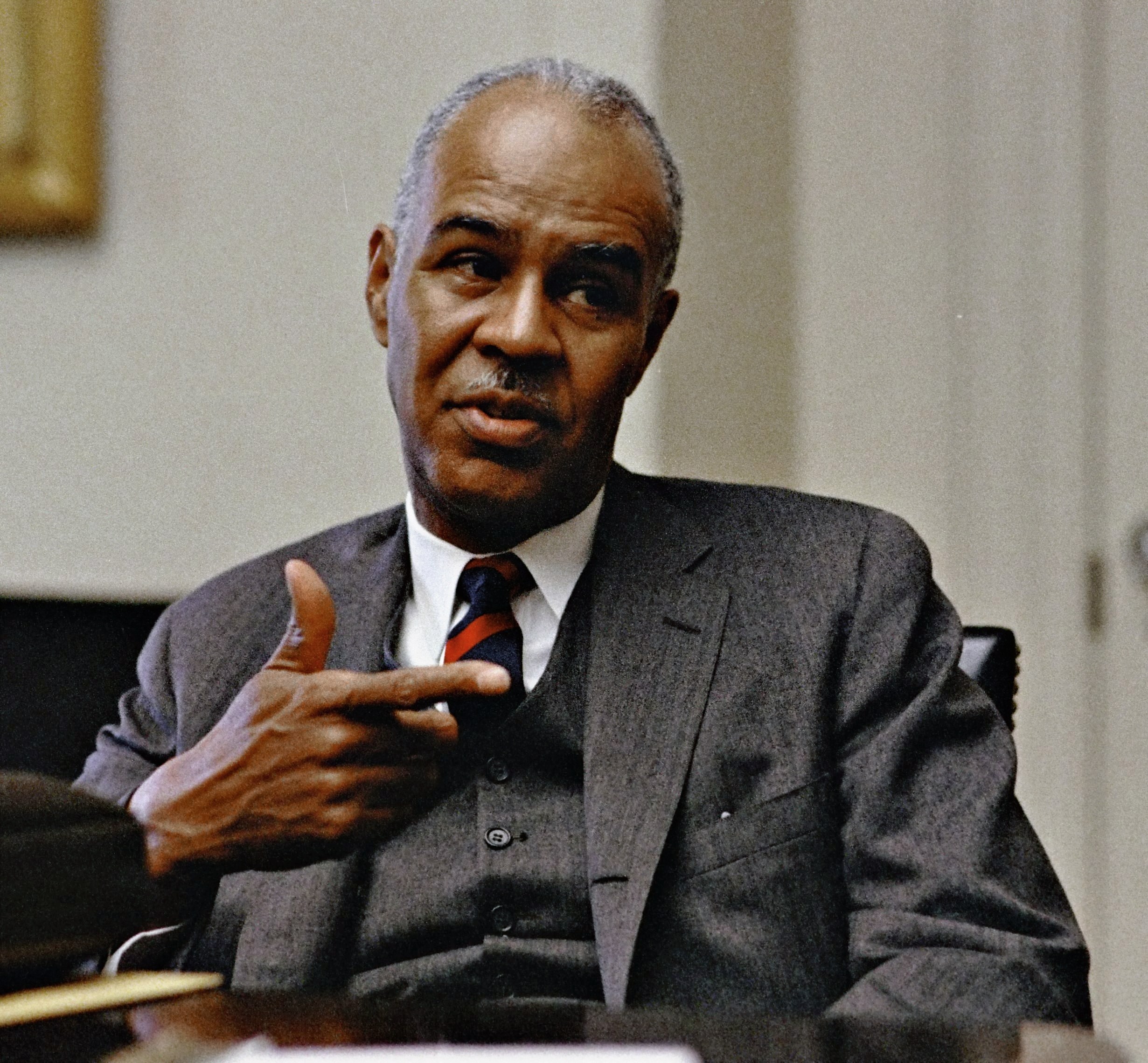 March on Washington, 1963
March on Washington, 1963
Topics on the Page
- 1964 Civil Rights Act and the 1965 Voting Rights Act
- Growth of the African American middle class, increased political power, and declining rates of African American poverty
- African American First in Other Sports
- African Americans and Professional Football
- Lesson plan about the Washington Redskins and racist names for sports teams
- African Americans and Golf
- Women during the Civil Rights Movement
- Combating the Radical White Community and the Rise of Black Power and Nationalism - The Black Panther Party
 Link to AP US History Key Concept 8.2: Civil Rights and Expanding Roles for Government
Link to AP US History Key Concept 8.2: Civil Rights and Expanding Roles for Government
Focus Question: What were lasting accomplishments of the Civil Rights Movement?
 Interactive Historical Timeline for milestones in African American history beginning in 1619.
Interactive Historical Timeline for milestones in African American history beginning in 1619.
 |
| Roy Wilkins, executive secretary, NAACP, 1968. |
- A Salute to Black History from Lawson State Community College in Alabama features pictures and images of famous African Americans from U. S. History.

 Selma Online
Selma Online
1964 Civil Rights Act and the 1965 Voting Rights Act
The Civil Rights Act of 1957 was a first step in ensuring voting rights for African Americans. It established a Civil Rights Division in the Department of Justice.
First brought about by President Kennedy, the Civil Rights Act of 1964 stated that:
- all children, regardless of race, should be able to attend the same schools
- no segregation in public places or the workforce would be allowed
- the unequal requirements for voter registration were null and void
The Freedom Summer of 1964, video, audio and photos. During Freedom Summer, many Northern, black and white, male and female college students into Mississippi to challenge that state's brutal segregation policies and to help blacks register to vote and get an education. The students were met with intimidation and violence from members of the KKK. The most famous case being the murders of Mickey Schwerner, James Chaney, and Andrew Goodman. Click here to find out more.
See what a program called Freedom Schools (based off of the 1964 program Freedom Summer) is doing to help African American and Latino students with their literacy skills, leadership skills, and cultural knowledge.
Click here to hear an interview with author Bruce Watson about his book Freedom Summer that documents the efforts of hundreds of American college students.
President Kennedy was assassinated before the bill could be presented before the House and the Senate, but President Johnson continued to push the bill. It passed in the House in February and then in the Senate in July. The Civil Rights Act of 1964 not only was intended to end racial discrimination but also declared that discrimination based on sex was illegal as well.

Link here for a video about the Civil Rights and the 1950s for a summary of the events that led up to the Civil Rights Movement and the events of the 1960s.
- Click here for a video from the History Channel showing Robert F. Kennedy addressing a crowd of supporters at his campaign rally after just hearing the news that Martin Luther King Jr. was assassinated that day, April 4th,1968.
Voting Rights Act of 1965
Lyndon B. Johnson meets with Martin Luther King, Jr., 1965

 The Voting Rights Act of 1965 stated that:
The Voting Rights Act of 1965 stated that:
- The literacy tests used to determine whether blacks could vote in the United States were null and void. Click here to take the Alabama Literacy Test from 1965 that was used to restrict African Americans from voting.
The Jim Crow Laws that were established after Reconstruction were successful in continuing discrimination against blacks by making them pass literacy tests in order to practice their right to vote.
- Even though legally, through the Fourteenth and Fifteenth Amendments, blacks were granted the right to vote after the Civil War, southern whites often engaged in violent activities that discouraged blacks from voting.
The Jim Crow Laws and the literacy tests were forms of disenfranchisement.
- Disenfranchisement is the taking away of civil or electoral privileges.
- This term is often used in association with the situation existing before the Civil Rights Movement.
 A lesson plan on the Jim Crow era. A lesson plan on the Alabama Literacy Test.
A lesson plan on the Jim Crow era. A lesson plan on the Alabama Literacy Test.
- Click here for a lesson plan about the Civil Rights Movement that focuses on how ordinary men and women struggled for their beliefs beyond the most famous names involved with the movement.
Growth of the African American middle class, increased political power, and declining rates of African American poverty
It is undeniable that racism still exists today in many places in American society. However, the strides made during the Civil Rights movement have greatly advance the situation of African Americans.
- Thanks in part to the anti-discrimination laws passed during the Civil Rights movement, the African American middle class began to grow during the 1960s.
- The rate of blacks graduating from high school and college jumped immediately following this period, which also led to better paying jobs being held by black Americans.
- While still disproportionately high, the poverty rate for African Americans also dropped after this period.
- Blacks have also becoming increasingly visible in the political sphere, holding many more politically powerful positions that prior to the Civil Rights movement.
Click here to read an analysis of the growth of the black middle class from Dateline.
Click here for a lesson plan on the election of Barack Obama, the first African-American President. This lesson focuses on the relation of the Civil Rights Movement to his election.
Click here for a timeline of African Americans and women in politics
African Americans in Congress by the Numbers from the Washington Post.
Women during the Civil Rights Movement
- Link here for an article from the Library of Congress about the involvement of women in the Civil Rights Movement.
- Link here to read an NBC News article that discusses the key roles women had during the Civil Rights Movement that has often been overlooked by historians.
Link here for a Democracy Now! YouTube video about Gloria Richardson, a civil rights pioneer and the co-founder of the Cambridge Nonviolent Action Committee in Maryland, which fought to desegregate public institutions like schools and hospitals. Although Richardson was on the event program for the March on Washington, when she stood to speak, she only had a chance to say hello before the microphone was seized from her and she was silenced.
Combating the Radical White Community and the Rise of Black Power and Nationalism
Huey Newton, co-founder of the Black Panther Party as "the American Che Guevara"

- In 1966, not long after the assassination of Malcom X, a vibrant symbol of the fight for civil rights (and a large source of inspiration for the Black Panthers) through his intelligence, eloquence and impassioned speaking skills, college students Bobby Seale and Huey Newton founded the Black Panther Party
- They had grown frustrated with the pace of the non-violent organizing tactics of the Civil Rights Movement
- called for the immediate end of police harassment and brutality in African American neighborhoods and ghettos
- issued a ten-point program that called for armed protection against police oppression, and other radical changes in America's capitalist system
- began a breakfast program for children, a food bank, and other social services to empower the poorest lower-class residents of Oakland (a largely African-American city)
- organized armed patrols of Oakland's poorest neighborhoods
- Emphasis was placed on Black Americans becoming well-versed in the art of self-defense, in the face of criminal and malicious persecution by many white terrorists including many police officers and authority figures
A video on the 1960's, with covering information about MLK and Malcom X
Explore more about the beginning of the Black Panther Party through images and audio
 Think: How can grass-roots movements be used by those other than by a politicians hoping to get elected to office?
Think: How can grass-roots movements be used by those other than by a politicians hoping to get elected to office?
Works Cited
Civil Rights Act-1964. Retrieved May 3, 2007, from Our Documents Web site: http://www.ourdocuments.gov/doc.php?flash=true&doc=97
Educators and Students: The Civil Rights Act of 1964 and the Equal Employment Opportunity Commission. Retrieved May 3, 2007, from The National Archives Web site: http://www.archives.gov/education/lessons/civil-rights-act/
Alabama Literacy Test circa 1965. Retrieved May 3, 2007, from Alabama Literacy Test Web site: http://kpearson.project.tcnj.edu/interactive/imm_files/test.html
Fourteenth Amendment to the US Constitution. Retrieved May 3, 2007, from NPS.gov Web site: http://www.nps.gov/archive/malu/documents/amend14.htm
Fifteenth Amendment to the US Constitution. Retrieved May 3, 2007, from NPS.gov Web site: http://www.nps.gov/archive/malu/documents/amend15.htm
http://dictionary.reference.com/browse/disenfranchise
Comments (0)
You don't have permission to comment on this page.